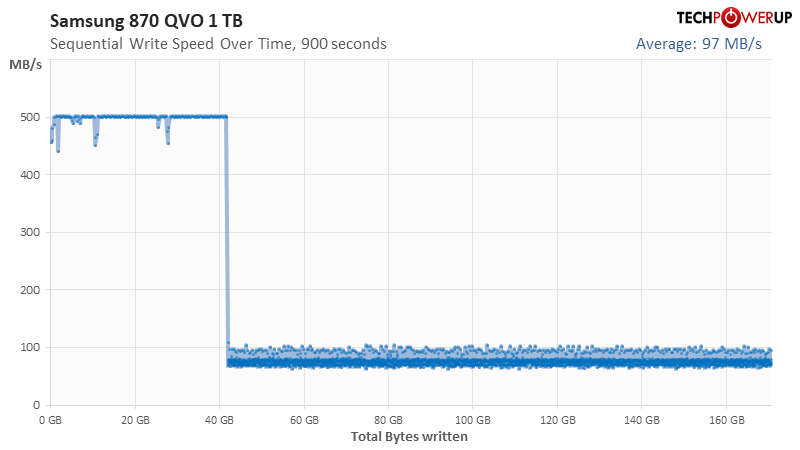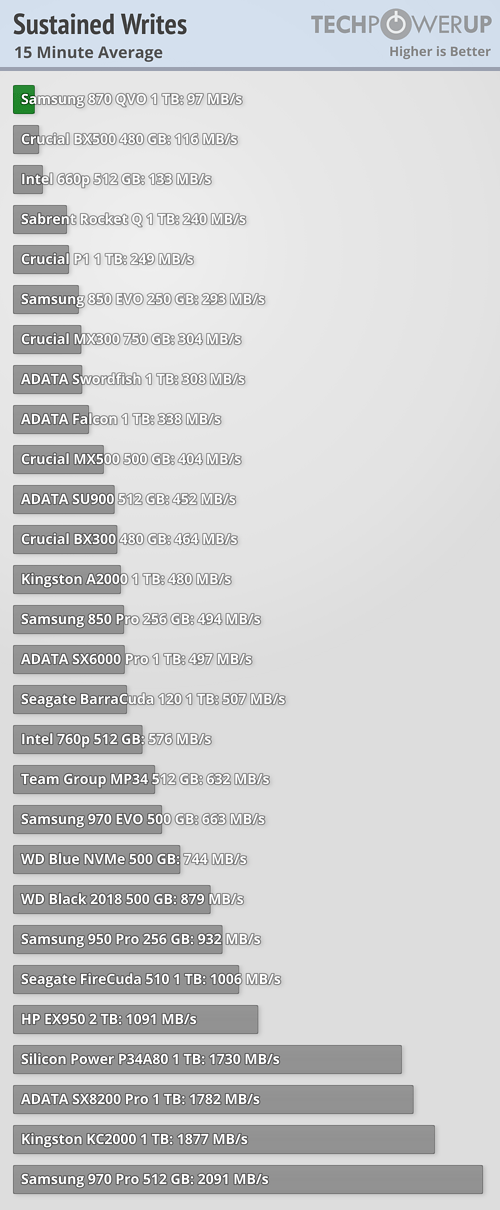 196
196
Samsung 870 QVO 1 TB Review - Terrible, Do Not Buy
Windows 10 Startup & File Compression »Write Intensive Usage
When copying games from your Steam Library or other very large files (>10 GB), you might have noticed that write speeds on your SSD start out at full speed and then drop considerably. The underlying reason is that modern drives have caches that soak up write bursts to improve performance. In the fairly uncommon scenario of writing data that's too big to fit into these caches, the drive will have to write data directly to flash, and it will probably juggle some out of its write cache at the same time, which can result in a significant loss of write speed. Newer TLC drives use part of their capacity in SLC mode for increased performance. This test can reveal the size of that SLC cache.Testing on this page looks at exactly that scenario. We write a sequential stream of 1 MB blocks to the drive in a single thread, like a typical file-copy operation would do, and measure write speeds twice a second. The drive is fully erased before testing to ensure any caches are emptied. Please note that this test writes a lot of data in a very short time, which is something most consumers will never do.

Just like all other modern SSDs, the Samsung 870 QVO has pseudo-SLC caching, which operates part of the total capacity in SLC mode, which is much faster than writing to QLC directly. When writing to an empty cache, we see excellent transfer rates of more than 500 GB/s—right at the limit of the SATA interface. Once you've written 42 GB, transfer rates fall off a cliff to below 100 MB/s—that is slower than most HDDs. It seems writing to QLC directly, possibly while trying to flush the SLC cache in the background, is a huge issue for the 870 QVO. At those rates it is the slowest SSD we have ever put through this test. The SLC cache is also relatively small, other QLC drives like the Crucial P1 and Sabrent Rocket Q have caches several times bigger.
Once the write activity stops and you give the 870 QVO enough time to flush the cache from SLC to QLC, write performance is restored.


Apr 25th, 2024 08:42 EDT
change timezone
Latest GPU Drivers
New Forum Posts
- (Anti) SFF fun house (354)
- What's your latest tech purchase? (20339)
- i7-12800HX Overheating Issues (0)
- Intel ARC Firmware Compilation Matrix (22)
- Alphacool CORE 1 CPU block - bulging with danger of splitting? (6)
- Bizarre Throttlestop issue (6)
- Core i5-6300U (17)
- Last game you purchased? (255)
- Share your AIDA 64 cache and memory benchmark here (2916)
- What phone you use as your daily driver? And, a discussion of them. (1472)
Popular Reviews
- Fractal Design Terra Review
- Thermalright Phantom Spirit 120 EVO Review
- Corsair 2000D Airflow Review
- Minisforum EliteMini UM780 XTX (AMD Ryzen 7 7840HS) Review
- ASUS GeForce RTX 4090 STRIX OC Review
- NVIDIA GeForce RTX 4090 Founders Edition Review - Impressive Performance
- ASUS GeForce RTX 4090 Matrix Platinum Review - The RTX 4090 Ti
- MSI GeForce RTX 4090 Suprim X Review
- MSI GeForce RTX 4090 Gaming X Trio Review
- Gigabyte GeForce RTX 4090 Gaming OC Review
Controversial News Posts
- Sony PlayStation 5 Pro Specifications Confirmed, Console Arrives Before Holidays (116)
- NVIDIA Points Intel Raptor Lake CPU Users to Get Help from Intel Amid System Instability Issues (106)
- AMD "Strix Halo" Zen 5 Mobile Processor Pictured: Chiplet-based, Uses 256-bit LPDDR5X (101)
- US Government Wants Nuclear Plants to Offload AI Data Center Expansion (98)
- Windows 11 Now Officially Adware as Microsoft Embeds Ads in the Start Menu (87)
- Developers of Outpost Infinity Siege Recommend Underclocking i9-13900K and i9-14900K for Stability on Machines with RTX 4090 (85)
- Windows 10 Security Updates to Cost $61 After 2025, $427 by 2028 (84)
- AMD's RDNA 4 GPUs Could Stick with 18 Gbps GDDR6 Memory (81)